
This is no ordinary greenhouse tour.
This is no ordinary greenhouse tour. Rosa Flora’s brand new Plant 5 is state-of-the-art, from lighting and coverings to water management and the stunning giant gerbera crop.
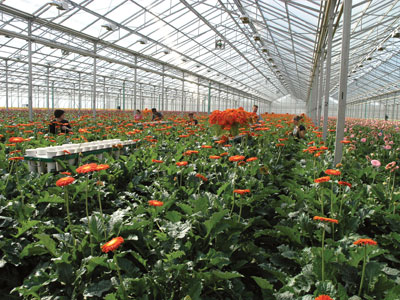 |
|
| Staff pick gerberas in Plant 5. Advertisement
|
Yet operations manager Ralph DeBoer isn’t showing me any of that just yet. Instead, the innovative grower leads us down the stairs to the tunnels below, eager to point out what to many would be dreary detail – the hot water pipes.
“In most greenhouses, these would be buried in the ground. Any heat lost in transport would be just that – lost,” he explains, pointing down a corridor running the length of the plant. “This way, any heat rises into the greenhouse, so nothing is wasted.”
ATTENTION TO EVERY DETAIL TO OPTIMIZE ENERGY USAGE
■ That’s the attention to detail possible when a key staff member is charged with managing the operation’s energy performance. DeBoer, a chemical engineer by education, estimates that between 30 and 50 per cent of his time is spent optimizing energy usage throughout the company’s 35-acre facility in Dunnville, Ont.
Although atypical for this industry, it’s a focus that other energy-intensive sectors are starting to adopt, including leaders in the forestry and cement industries.
It’s a focus that makes sense in the greenhouse sector, as energy represents roughly 40 per cent of an average greenhouse’s costs, second only to labour. It also reflects what has become a trademark for Rosa Flora – a long-term commitment to proactive energy management.
CONTINUING A TRADITION OF INDUSTRY INNOVATION
■ That drive to turn a variable cost into a competitive edge touches many aspects of the company’s operations. Rosa Flora’s road to energy efficiency can be traced back to the mid-1980s, during the construction of Plant 2. Owners Otto and Corine Bulk decided to build two-thirds of the plant using double-pane acrylic, starting a company trend that is still unusual, as DeBoer explains.
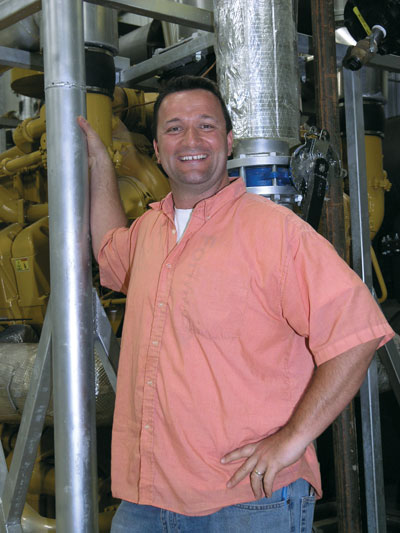 |
|
| Ralph DeBoer, operations manager at Rosa Flora, with the newest Caterpillar CHP system. “Between 30 and 50 per cent of my time is spent working on the energy side of the business, whether efficiency or as a business itself.”
|
“It was the Cadillac of coverings, and still is, so it’s not that common. It’s expensive, so you have to be in it for the long haul. We’ve found the diffused light is really good for crop quality, and at the same time it gives us very good energy efficiency without having to use curtains.”
Since then, Plants 3, 4 and 5 have been built exclusively with double acrylics, and DeBoer doesn’t doubt the ROI at all (Plant 1 and part of Plant 2 use energy curtains).
“We just replaced the original covering on Plant 2, so that’s lasted 27 years. When you look at the energy and growing benefits over that time, the investment has made a lot of sense.”
This willingness to invest in energy efficiency is consistent throughout the company’s history, from the use of alternative and renewable energy sources to energy efficiency initiatives, and most recently the company’s expanding power generation business.
FIRST BIOMASS SYSTEM INSTALLED ABOUT A DECADE AGO
■ Rosa Flora’s first foray into renewables came in 2003, when management decided to hedge their bets on natural gas price swings by adding a biomass heating system. The system and its fuel sources have been optimized over time, and today bioenergy accounts for 80 per cent of heating needs.
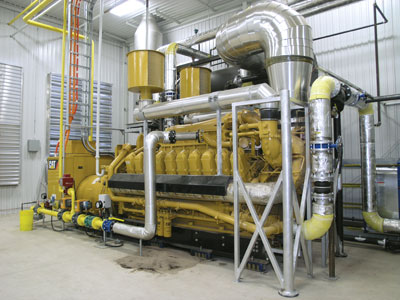 |
|
| Installed by Toromont, the two new Cat high-efficiency natural gas generators add 4 MW power to the company’s energy business. over 90 per cent efficiency, CHP is a very attractive opportunity for us going forward,” operations manager Ralph DeBoer explains.
|
Currently, Rosa Flora sources construction waste from the Greater Toronto Area (GTA), diverting material from landfill and replacing fossil fuels. Fuel quality, or lack thereof, is traditionally the biggest hurdle when moving to raw biomass. While maintaining a consistent supply was initially a challenge, DeBoer says they have solidified relationships so that the supply chain is now reliable.
“We’ve essentially taken the whole chain over, so we control supply and quality right through to combustion. We have our own biomass processing facility on site where we grind and screen the fuel, and that has been a big help in reducing maintenance issues inherent with poor quality biomass.”
The biomass system includes three combustors designed to burn biomass (two KMW slope reciprocating grates and a Blue Flame Stoker travelling chain grate), and a CBI horizontal grinder producing a uniform fuel supply.
WIND TURBINE HELPS LOWER ELECTRICITY COSTS
■ Rosa Flora has also invested in a massive 600 kW wind turbine. Installed in 2006, it has since become an area landmark and symbol of the grower’s energy innovation. It is much more, DeBoer explains.
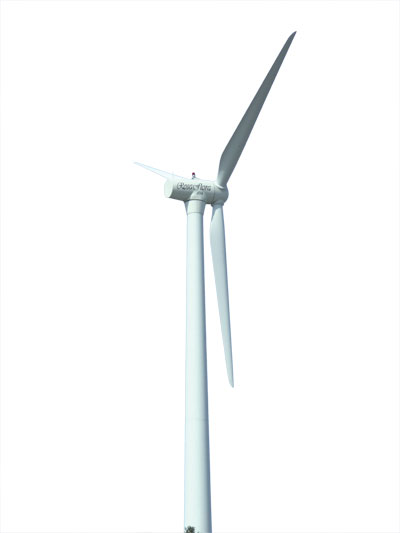 |
|
| The wind turbine supplies between five and 10 per cent of electricity needs. |
“The interest was to offset kilowatt hours that were purchased off the grid. It’s wired directly to the Rosa Flora grid, so anything it produces directly offsets kWh that would have been purchased.”
DeBoer admits it was an expensive investment to supply between five and 10 per cent of the company’s electricity needs. Still, he says it reflects the owners’ goal to continually position the company as cost leaders. It also reflects a longer-term perspective than many growers are willing to adopt.
“ROI is always a tricky balance, and some of these energy investments are longer-term than some growers would be comfortable with. Wind power is definitely one of those where you’re looking beyond the three- to five-year window some companies look for. If we see an investment that is sound as it relates to our core business of growing flowers, we’re open to that.
“Electricity will always be key for us – we know we’ll continue to need light to grow our flowers, and we see electricity prices continuing to rise in Ontario. So if we see equipment that generates kilowatts that we won’t have to buy down the road with an ROI that we’re comfortable with, we’ll go for it. Today, we’re benefitting from investments made 10 or even 20 years ago. That’s the perspective we tend to have.”
EFFICIENT BY DESIGN TO MINIMIZE ENERGY USAGE
■ Once that heat and power is generated, Rosa Flora aims to make the most of it. Its newer structures, like the recently commissioned Plant 5, include state-of-the-art design to minimize energy usage. It starts with double-pane acrylic, which creates an insulating air layer to hold heat in. Lighting is also carefully considered, given that some crops require very long lighting hours.
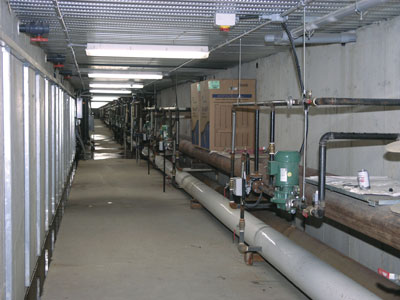 |
|
| Heating pipes run from the boilers to Plant 5 via underground tunnels that transfer any heat loss to the greenhouse floor.
|
“We’ve put in best-in-class bulbs, fixtures, reflectors. The lighting infrastructure itself, how it’s wired – we’ve spent time and energy making sure it is as efficient as possible.”
The company also uses its control systems to make sure light is used as cost effectively as possible, balancing the investment in lighting conditions with the incremental growth it can provide. “We focus on how we manage lighting – when do you light to maximize production versus cost, and when do the costs of incremental lighting outweigh the benefits.”
The controls are also set to automatically shut the lights off at any time when sufficient natural lighting is available.
THERMAL EFFICIENCY IN THE 90 PER CENT RANGE
■ Plant 5 also highlights another of the company’s long-term energy initiatives – combined heat and power generation. Off to one corner of the plant is a high-efficiency Caterpillar natural gas generator. It is the company’s fourth unit, with the first two Cat 800 kW (electrical) installed in 1991, and the most recent pair of Cat 2 MW units commissioned in 2010 and 2011, for a total of 5.6 MW of electrical and 8 MW thermal. Along with renewable energy, it is an area where DeBoer sees exciting opportunities.
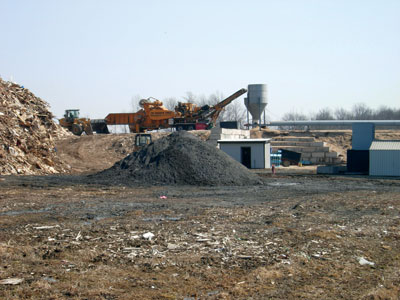 |
|
| Rosa Flora’s CBI horizontal grinder was added to improve the quality of incoming wood waste. “Quality control was a primary driver,” says Ralph DeBoer, “but the economics made sense as well given the volume we are consuming. PHOTO COURTESY ROSA FLORA
|
As he explains, the beauty is the greenhouse sector’s ability to achieve thermal efficiency in the 90 per cent range, versus the 40 to 45 per cent range for sectors that only need the power or only use the heat.
“We’re getting that 40 to 42 per cent efficiency off the power, but then we extract another 50 per cent off the heat that we can use, which makes for a pretty hard to beat combination both economically and environmentally.”
How much the generators are used depends on the spread between natural gas prices and electricity rates at any given time. With today’s attractive natural gas prices, DeBoer admits that the short-term looks pretty good.
In general, the main generating season is September to March, when the grower’s heat and lighting needs and highest, although the units are available at any time should there be a nasty cold snap or the biomass units fail to meet demand. The units also allow tri-generation, injecting CO2 into the greenhouses from the generator stacks, an option not being used when we were on site.
HOT WATER STORAGE AS A HEAT BUFFER
■ Adding to that flexibility is over three million litres of hot water storage, which serves as a heat buffer.
Touring the control room housing the new Cat generator, DeBoer points out that the wiring and space is in place to add more capacity.
“Given where we expect to see electricity rates in coming years, power generation is an area we’re getting more into, and CHP is an area we feel will continue to add value by being able to extract both heat and power very efficiently by using state-of-the-art natural gas generators. I think it’s an area we will continue to invest in.”
And why not? With much of Canada’s cut flower business under some pressure, Rosa Flora is building on its quality, relationships, and energy efficiency to continue to expand. It’s a strategy that appears to be paying dividends.
“We continue to track all our energy usage over time, electricity and gas, looking for issues or opportunities. It is part of our success, and we’ll make sure it continues to be.”
Scott Jamieson is the editorial director of Greenhouse Canada.
Print this page